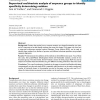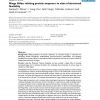16 search results - page 2 / 4 » PROFbval: predict flexible and rigid residues in proteins |
BMCBI
2008
13 years 11 months ago
2008
Background: A multiple sequence alignment (MSA) generated for a protein can be used to characterise residues by means of a statistical analysis of single columns. In addition to t...
BMCBI
2007
13 years 11 months ago
2007
Background: Proteins that evolve from a common ancestor can change functionality over time, and it is important to be able identify residues that cause this change. In this paper ...
TCBB
2010
13 years 9 months ago
2010
— Analysis of conformational changes is one of the keys to the understanding of protein functions and interactions. For the analysis, we often compare two protein structures, tak...
BMCBI
2007
13 years 11 months ago
2007
Background: Relating features of protein sequences to structural hinges is important for identifying domain boundaries, understanding structure-function relationships, and designi...
BMCBI
2008
13 years 11 months ago
2008
Background: Structural alignment is an important step in protein comparison. Well-established methods exist for solving this problem under the assumption that the structures under...


